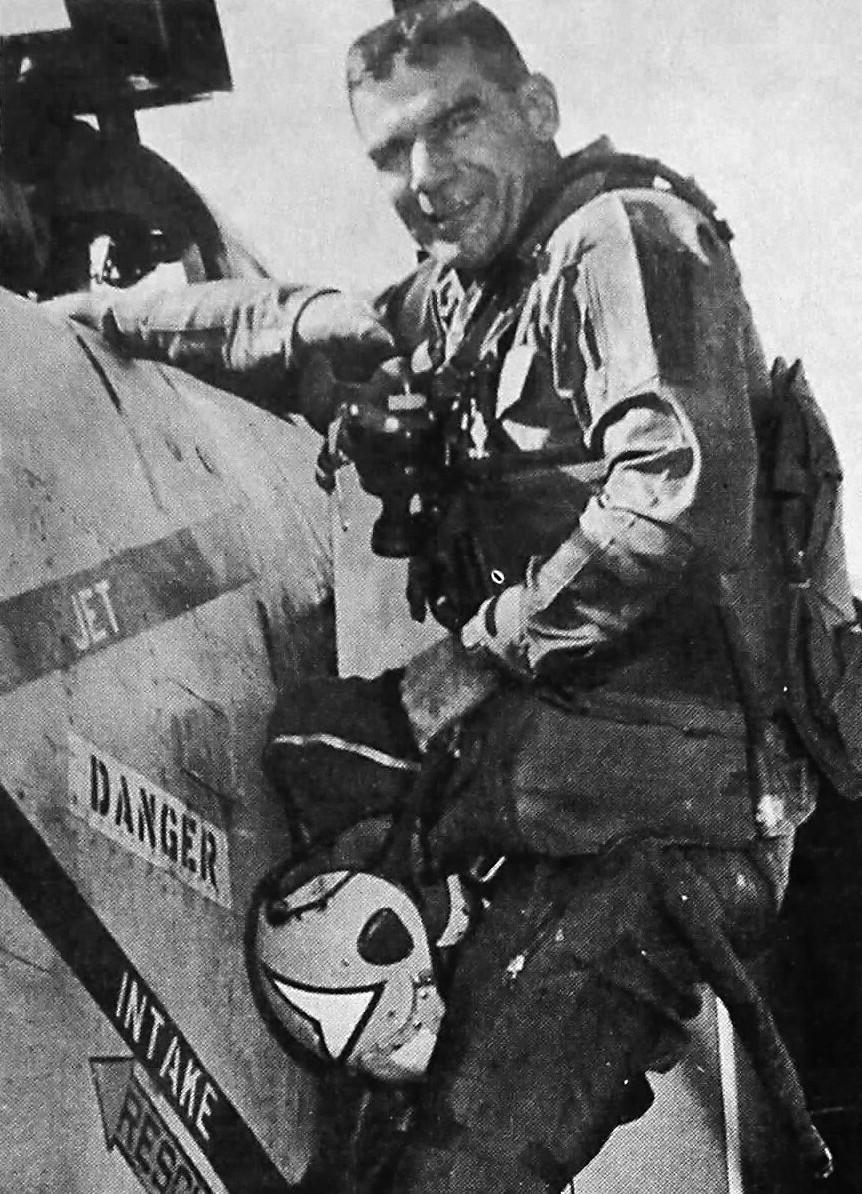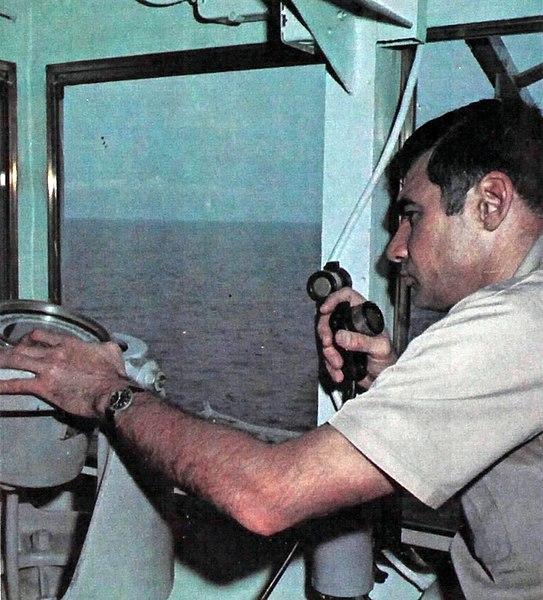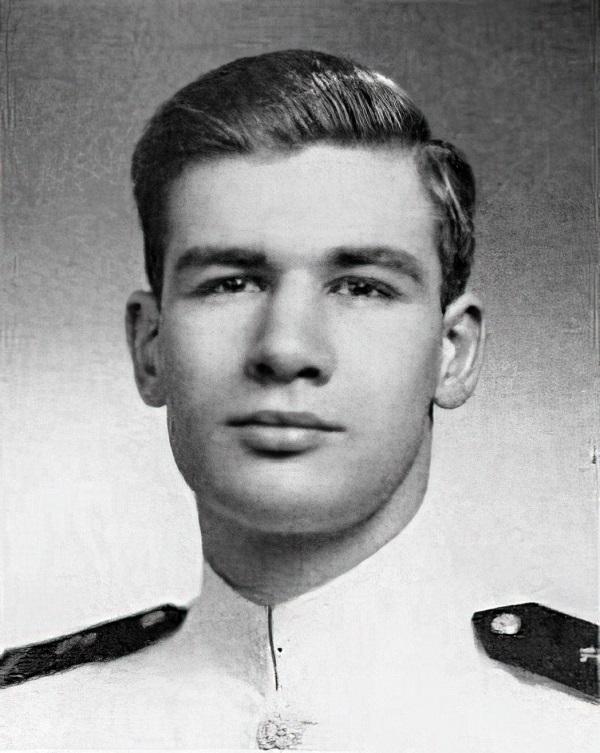Alexander G. B. Grosvenor was a Navy captain, a pilot, carrier officer, and yachtsman. He was born on December 7, 1927, in Washington, D.C., to Melville Bell Grosvenor, who was the editor of the National Geographic Magazine, and Helen Rowland. Alexander Grosvenor died on April 7, 1978, at the age of 50, after suffering from brain cancer at the Naval Hospital in Annapolis. He was survived by his wife, Marcia, two daughters, Pamela and Sandra, and his parents, as well as his brother, Gilbert M. Grosvenor, who was the former Chairman of the National Geographic Society. Alexander G. B. Grosvenor was the great-grandson of the inventor, Alexander Graham Bell, and brother of Gilbert M. Grosvenor, former Chairman of the National Geographic Society, and son of Melville Bell Grosvenor (who, in turn was the son of Elsie May Bell, Alexander Graham Bell’s daughter).
Grosvenor enrolled in the United States Naval Academy in 1945 and graduated in 1950, sailing the Naval Academy’s Star in the 1949 World Championships in Chicago. He earned a letter on the varsity dinghy team and was the first midshipman skipper of the yacht ROYONO in the 1950 Bermuda Race. He subsequently wrote about his experiences on a Navy training exercise to Europe in an article co-authored with fellow midshipman William J. Aston entitled “Midshipmen’s Cruise” published in the June 1948 issue of National Geographic.

Commander Alexander G.B. Grosvenor, U.S. Navy, commanding officer of Fighter Squadron 21 (VF-21) “Freelancers” stands on one of the squadron’s McDonnell F-4B Phantom II aboard the aircraft carrier USS Ranger (CVA-61). VF-21 was assigned to Attack Carrier Air Wing 2 (CVW-2) aboard the Ranger for a deployment to the Western Pacific and Vietnam from 4 November 1967 to 25 May 1968.
After graduating from the Naval Academy, Grosvenor served aboard the Saipan-class light aircraft carrier USS Wright (CVL-49) and then served two tours in Korean waters aboard the Essex-class aircraft carriers USS Yorktown (CV-10) and USS Essex (CV-9), piloting the Navy’s first swept-wing jets. Following a tour as a flight instructor, he served in the Mediterranean aboard the USS Saratoga (CV-60) as aide and flag lieutenant to Commander, Sixth Fleet.
During the Vietnam War, Grosvenor served with Fighter Squadron 21 (VF-21) Freelancers during combat tours in southeast Asia aboard the carriers USS Coral Sea (CV-43) and USS Ranger (CV-61). An F-4B fighter jet flown by Grosvenor when he was squadron commander of the Freelancers, now known as “The Midway Phantom,” is on display at the San Diego Aircraft Carrier Museum.

Captain Alexander G.B. Grosvenor, U.S. Navy, Executive Officer of the aircraft carrier USS Kitty Hawk (CVA-63). Kitty Hawk, with assigned Attack Carrier Air Wing 11 (CVW-11), was deployed to the Western Pacific and Vietnam from 6 November 1970 to 17 July 1971.
After graduating from the Naval War College in 1969, Grosvenor served as operations officer of the USS Kitty Hawk (CV-63), and the following year as executive officer. In the early 1970s, Grosvenor served at the Naval Air Station Patuxent River where he was “director of testing for some of the Navy’s newest aircraft,” according to the Annapolis Capital.
In March 1975, Grosvenor was appointed commander of the Annapolis Naval Station and commodore of the Naval Academy Sailing Squadron, where he promoted a resurgence of sailing at the Naval Academy. He is credited with turning around the midshipmen sailing program and bringing the Mids back on blue water. He established an offshore division of the sailing team, which previously was just dinghies and shields, and helped train and lead a group of midshipmen on a sailboat offshore. His wife, Marcia, frequently assisted him in his sailing duties and authored a manual on cooking while sailing at sea, the Gimbaling Gourmet Galley Guide.
Grosvenor was awarded the Distinguished Flying Cross, the Bronze Star, and the Navy Commendation Medal with Combat “V.” The A.G.B. Grosvenor Trophy is awarded annually to the volunteer member of the Naval Academy Sailing Squadron who has made exemplary contributions to the mission and programs of the sailing squadron. The trophy was established in 1978 to honor Grosvenor, the commanding officer of Naval Station Norfolk, Virginia, and a former sailing coach at the Naval Academy. Grosvenor was known for his leadership and dedication to the sport of sailing, and the trophy serves as a reminder of his contributions to the Naval Academy and the U.S. Navy. Today, the A.G.B. Grosvenor Trophy remains a prestigious honor that recognizes the exceptional achievements of volunteer members of the Naval Academy Sailing Squadron.
In 2017, the Naval Academy named one of its newest training boats, a 44-foot Colgate, after Grosvenor, in recognition of his contributions to sailing at the academy.
Grosvenor was widely admired for his leadership, character, and integrity. According to a remembrance written by his daughter Pamela Grosvenor Mongan for the Naval Academy Alumni Association, “my father believed that character, integrity, and honor are the bedrock of successful leadership, and that leaders must demonstrate a deep commitment to their principles and their people.”
Mongan described her father as “a quiet and unassuming leader who led by example, treated everyone with respect, and cared deeply about his people. He was someone who commanded respect because he was worthy of it, and because he respected the people he led.”
Grosvenor’s legacy lives on in the countless midshipmen who have benefited from his leadership and mentorship, as well as in the annual award that bears his name. His contributions to the Naval Academy and the Navy will long be remembered and celebrated, and his example of leadership and service continues to inspire generations of sailors and officers.
References:
- https://en.wikipedia.org/wiki/Alexander_G._B._Grosvenor
- https://www.washingtonpost.com/archive/local/1978/04/09/navy-capt-alexander-grosvenor-50/57a9c789-e99f-43a1-8bbf-b97648880d70/
- https://commons.wikimedia.org/wiki/Category:Alexander_G.B._Grosvenor
- https://military-history.fandom.com/wiki/Alexander_G._B._Grosvenor










